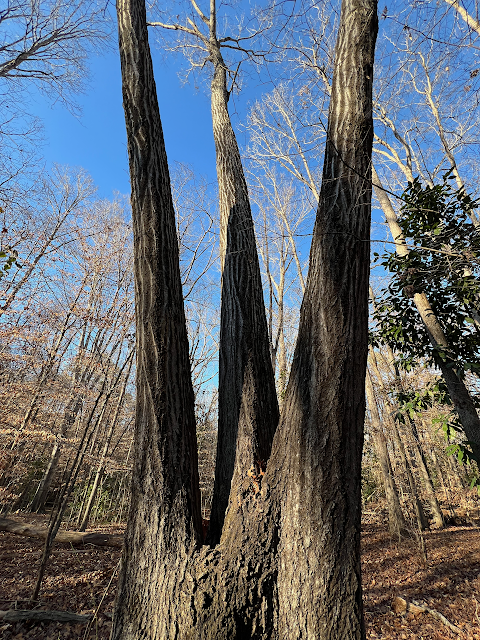 |
| This is "My Place" |
I just began a year-long online project, "Journey in Place" with author, Janisse Ray. The purpose of the project is for the participants to create connection and relationship with a place-- a yard, a park, a city or a region. As Janisse explains, we have become "placeless people" who have lost our ties to the earth we live on and the natural processes around us. We will be going through weekly exercises designed to help familiarize ourselves with a place, whether it be a yard, a park, or a region, and form deeper connections. (You can sign up too by subscribing to her "Trackless Wild" Substack newsletter.)
 |
Woodsy Trail
|
I'm excited about this project because "place" has been on my mind for some time now. In fact, I wrote a blog about this nearly 10 years ago when I lived in Florida. (
"A Sense of Place"--click here to read) I now live in Georgia, very far from where I grew up in Salt Lake City, Utah, and after 8 years here, I still feel like an outsider. I have not lived in Utah for 35 years, yet, when someone asks where I am from, I always want to say "Utah". My roots are there. But Utah is not my home any more. Many of my people that connected me to the state have died or moved away. The city and region have grown so much that I hardly recognize it. The Great Salt Lake is drying up, which breaks my heart. I don't think I could ever move back because the place has changed and I've changed. But there's still this familiarity and the memories. The mountains. The smell of summer. The hard, dry dirt. It's complicated. I
live in Georgia but I'm
from Utah.
 |
| Wasatch Mountains behind the Salt Lake Valley (Taken through a window--excuse the glare) |
I will never be able to match the ancestral yearning that I feel when I look at the Wasatch Mountains that rise behind the Salt Lake valley in another place. But I want to get to know rivers, stone outcrops and red clay where I live now. I want to know about the rainfall and temperature patterns. Is this a hard winter? When is the typical rainy season? I want to know the plant, animal and insect cycles. I want to internalize the history of the land, the geology and the people. I want to grow deep roots.
 |
| A Snail Eating Fungus |
 |
Curled Oak Leaves that look like clasped fingers
|
 |
| Cranefly Orchid Leaf--Greenery in Winter |
 |
| Fungus rings an old log |
My 1st task was to pick "my place" that I'll be coming to and getting to know throughout the year. I've read comments from other participants and some chose the land they and their families have lived on for generations, or their yard, or a river gorge. I decided to pick a recreation and nature park on the UGA campus, "Lake Herrick and Oconee Forest Park". It is special to me because it is part of my neighborhood, but also because of what it meant to me during Covid. In the early months of the pandemic, our city, like many others, shut everything down. The university closed and sent the students home, and they closed the State Botanical Garden, which is operated by the university. The City made the decision to close the parks and playgrounds to keep crowds from gathering. In the early weeks of the shut down, Lake Herrick was one of the only nature areas in town that was open to the public, and I walked there most days. In times when it felt like the world was falling to pieces, I found connection, refuge and solace walking through the woods and around the lake. As things eased up a bit, the other parks opened again for walking because we realized how important exercise and nature therapy were for us. People started venturing out again, and the university opened the parking garage next to the lake as a safe, socially distanced practice space for brass and woodwind musicians. I'll never forget the lonely sound of a trombone wafting over the lake as I walked one morning in December. It was a weird and difficult time.
 |
| Barred Owl Watching |
 |
| Bloodroot Patch |
Within our "place" we were instructed to find what I'm calling my "comfort spot"--a place that draws me and where I can come back to over and again for contemplation and reflection and close examination. I picked a spot on a hillside overlooking tall trees, with the lake in the distance. On one of my walks near here, I discovered a beautiful patch of white Bloodroot blooming on a quiet trail. It was like a finding a treasure. Another morning I spotted a Barred owl perched near the Bloodroot trail. A couple of hawks were unhappy that it was there and made a noisy fuss. Nearby I watched as a Brown Creeper moved up and down the trunk of a pine tree, and across the road Pileated Woodpeckers tore chunks off of a log looking for grubs. I visited this spot the other day and saw a pair of Red-headed Woodpeckers. It was the first time I'd seen them in these woods for several years and I took it as a sign that this would be a good choice for my "comfort spot". As we say in Utah, "This is the Place". I look forward to getting to know it better.
 |
| Wintery Steam |
 |
| Mossy Log in my "Comfort Spot" |
 |
| Looking through the trees at the lake below |
 |
| Reflections on the Water |
 |
| "This is the Place" Monument, Salt Lake City |























































